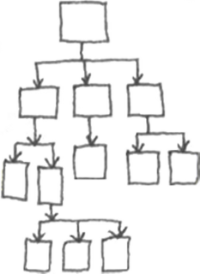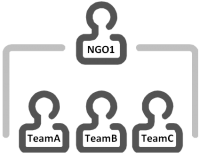Auxiliary data provide supplementary or additional information to items and include Country Structure, Assistance classification, Cause classification, Needs classification, Ordnance classification, Organisations and Places. Note that Tasks are not included in neither items or auxiliary data.
Contents
Assistance, Cause and Needs classifications
These classifications are used in Assistance and Victim items.
- Cause for someone having become a victim
- Needs that the victim is assessed to have
- Assistance that the victim has received
They are as the Country Structure tree structures. Ideally, a Mine Action Programme uses official, countrywide classifications that ensures mine action information is compatible with other national datasets. IMSMANG contains a set of pre-defined levels of classifications. These should be seen as a starting point for discussions in each Mine Action and/or Assistance Programme.
| Cause | Needs | Assistance | |
|---|---|---|---|
| Level 1 | Cause | Needs | Assistance |
| Level 2 | Event | Phase | Phase |
| Level 3 | Type | Type | Type |
| Level 4 | Subtype | Subtype | Subtype |
| Level 5 | Specification | Specification | Specification |
| Level 6 | Detail | Detail | Detail |
These classifications may have maximum of ten levels. These classification can be extensive and therefore the Advanced Search functionality is useful for finding what you are looking for. The inspiration classifications that serve a starting point for discussions in each Mine Action and/or Assistance Programme can be downloaded in Excel files from here.
Country Structure
The Country Structure represents a gazetteer, the political or administrative divisions within a country. In IMSMANG, the Country Structure allows a Mine Action Programme to link Mine Action information to areas and report statistics such as number of victims per province or district. Ideally, a Mine Action Programme uses an official, countrywide Country Structure that ensures mine action information is compatible with other national datasets.
Ideally, the Country Structure in IMSMANG, covers all levels of the existing Country Structure, from the country level down to a level that can be represented with a single point such as a town or village. If a Mine Action Programme has special levels such as Areas of Responsibility that do not exist in the Country Structure, artificial levels may be inserted into the Country Structure in IMSMANG.
To display a Country Structure node like a town or village on the map, it is necessary to add a geographic coordinate for the node.
| |
If the Country structure is extensive and/or in several languages then the Advanced Search is useful for finding what you are looking for and in version 6.0 it is also possible to search on Alternative names. |
Ordnance Classification
This classification is used in Land, Activities and Accidents. IMSMANG includes from the installation more than 5,000 predefined ordnance models. All ordnance is grouped according to categories and subcategories. For example, an ordnance may have a category of “Landmine” and a subcategory of “Antipersonnel.” In this way, IMSMANG provides the ability not only to search and report on models but summarise information on categories and subcategories. This allows queries such as “how many landmines or bombs were cleared in a specific period?” or “how many anti-personnel mines were found?”.
| |
Other categories than Landmines have ordnance that belong to the subcategory Anti-Personnel so if you only want to report on AP-mines you need to filter on both category and subcategory. |
Furthermore, Mine Action Programmes can limit which ordnance can be used for data entry by making ordnance inactive. To making only the ordnance that may be found in the country facilitates both data entry and data quality.
| |
|
Organisations
IMSMANG provides the ability to track information about Organisations participating in Mine Action. Organisations can be categorised by type and assigned “work areas” based on the Country Structure.
Additionally, IMSMANG supports the creation of parent-child relationships with organisations so that information managers can create hierarchies of organisations. For example, a mine clearance organisation may be responsible for several clearance teams within a country. As shown in the figure below, this relationship can be mapped by creating one organisation for the mine clearance organisation (NGO1) and one organisation for each team (TeamA, TeamB and TeamC), then specifying the parent organisation of each team as NGO1.
Example Hierarchy of Organisations
This kind of hierarchical relationship allows for complex searching and reporting on information such as how many square meters were cleared by each team and the total square meters that were cleared by the entire organisation.
IMSMANG also supports the tracking of competencies and accreditations for each organisation.
Places
IMSMANG offers the option to track information about specific places or infrastructure elements within a country that are relevant to Mine Action. These can be ammunition storages, armouries, airports, community centres, hospitals, refugee camps or any other structures/buildings which designate a political, economic, social, and/or logistical value.
Places can be linked to:
- Land and Activities to represent the nearest medical facilities
- Land and Activities to represent ammunition storage or armoury
- Victim to represent hospital
- Assistance to represent Place where the Assistance took place
- Education activities to represent the location of the activity
As with other IMSMANG data, Places may be represented on the map by adding geospatial information. Place may be represented on the map as both points and polygons e.g. for a refugee camp the polygon indicates larger area around the camp where people are moving for collection food and water.
| |
Ammunition storage and Armoury have been added to Place Type |
Import Auxiliary Data
To import auxiliary data using an Excel spreadsheet, refer to XLS import.

